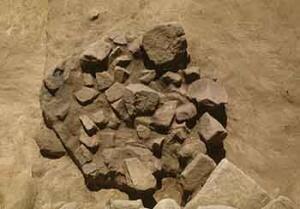- Home
- Megalithism in Morbihan
- Locmariaquer
- Before the megaliths
- Introduction
- Carnac
- Gavrinis
-
Locmariaquer
- The peninsula and its monuments
- A cradle of archeological research
- Before the megaliths
- Grand-Menhir (Great Menhir)
- Er-Grah Tumulus
- La Table-des-Marchands (Merchants’s table)
- From Mané-Lud to Mané-er-Hroeg
- Pierres-plates (Flat Stones), a late tomb
- Megalithic art in Locmariaquer
- Locmariaquer, from Antiquity to the Middle Ages
- Le Petit-Mont
- Architectural types
Unlike Carnac, the Locmariaquer Peninsula has up to now revealed no signs of any Palaeolithic human settlement, probably because of the lack of appropriate "sediment traps". The first significant signs only date back to the Neolithic, but they seem to mark the very beginning of the Neolithic settlement of Armorica.
The Kerpenhir peat-bog
As in many places along the coast, a "coastal peat-bog" was recorded in 1883 near the Kerpenhir headland at the south-western end of the commune. The 1.5m thick peat-clay formation which emerges only at the lowest tides was studied within the framework of a general study of Neolithic paleoenvironments in the area.
The pollen diagramme drawn up by L. Visset and his team shows signs of cereals as early as the 6th millennium BC, at the time of the late Teviecian Mesolithic groups.
The long-lasting settlement of the area by Neolithic communities is made very clear by the "pollen spectrum" of the peat-bog at the end of the 6th millennium BC with the sudden and protracted retreat of the forest cover, a sudden proliferation of "ruderal" plants and the constant presence of cereals until the end of the untouched peat sequence, between the 3rd and 4th millennia.
Simplified view of the Kerpenhir peat-bog pollen diagramme at Locmariaquer
Under the Er-Grah tumulus
Fortunately, the megaliths recently studied at Locmariaquer covered and protected a thick fossil soil which showed many traces of settlements pre-dating the construction of the monuments.
Under the Er-Grah tumulus, two particularly old structures are already clearly ritual.
- A subcircular fireplace with an average diameter of 0.8 m, stone-filled with gravel and a few bigger flat stones, gave a radiocarbon dating with a "calibration range" of between 5400 and 5100 BC, i.e. during the agricultural "boom" at Kerpenhir.
- Only a few metres away, a pit revealed two bovine remains which had apparently been skinned and almost entirely emaciated before being buried. The animals (one male and probably one female) were very large, and still rather similar to wild aurochs; However, anatomical details given by A. Tresset indicate that they were already domesticated. The upper part of the pit was probably filled in between 4950 and 4700 BC but the animals could have been buried before, around the time when the nearby fireplace was in use.
One of the stone-filled pits, revealed in the untouched fossil soil, under the Er-Grah tumulus.
Remains of the two sacrificed bovines in their pit. The grey spot on the picture marks the location of the very old fire place, left of the small trench.


